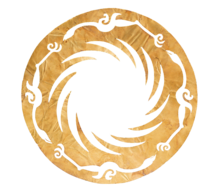
The three-legged (or tripedal) crow is a mythological creature in various mythologies and arts of East Asia. It is believed to inhabit and represent the Sun.
Evidence of the earliest bird-Sun motif or totemic articles excavated around 5000 BCE at China. This bird-Sun totem heritage was observed in later Yangshao and Longshan cultures.[1] Also, in Northeast Asia, artifacts of birds and phoenix observed to be a symbol of leadership was excavated to be around 5500 BCE in Xinle culture and later Hongshan culture from Liao river basin.[2]
The Chinese have several versions of crow and crow-Sun tales. But the most popular depiction and myth of the Sun crow is that of the Yangwu or Jinwu, the "golden crow".[3] It has also been found figured on ancient coins from Lycia and Pamphylia.[4]
- ^ Chinese Prehistory
- ^ Sarah Milledge Nelson (2019). Shamanism and the Origin of States: Spirit, Power, and Gender in East Asia.
- ^ Yatagrarasu: The three-legged crow and its possible origins
- ^ Volker, T. (1975). The Animal in Far Eastern Art and Especially in the Art of the Japanese. Brill. p. 39.